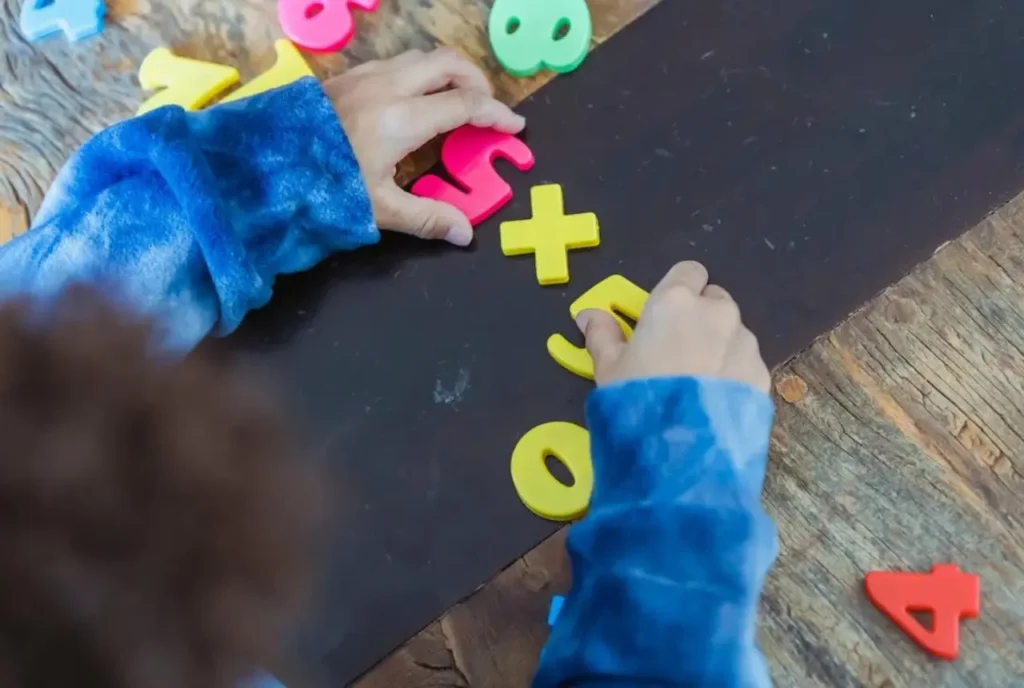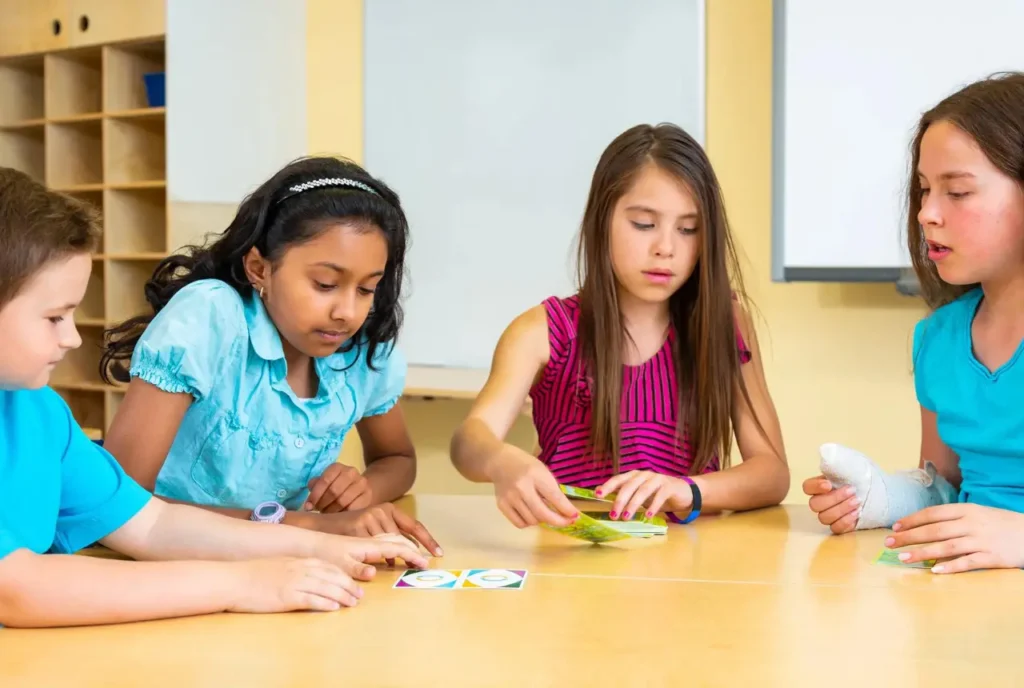![]()
Math games in the classroom are a great way to make learning more exciting and interactive. They turn tricky concepts into fun activities, which helps students understand and remember better. These games boost students’ enthusiasm and keep them engaged.
Today, we’re going to cover five cool math games you can use: Fraction Frenzy, Geometry Scavenger Hunt, Multiplication Mania, Probability Poker, and Math Jeopardy. Each game has its own twist on learning math, so you can keep things fresh and interesting for your students.
Fun Math Games for Learning: Enhancing Classroom Engagement
Imagine a classroom where textbooks turn into treasure maps and flashcards become ninja stars! Games can transform your math lessons into exciting adventures. But why are games so effective?
Using games in math class isn’t just about adding a bit of fun. It’s a smart way to boost engagement and learning. Games tap into our natural love for competition, challenge, and surprise, keeping students motivated and excited. Unlike passive lectures, games involve active learning. Students become explorers, experimenting with solutions and solidifying their understanding through hands-on experiences.
1. Number Ninjas: Addition and Subtraction Challenge
Number Ninjas is an interactive game where players tackle addition and subtraction challenges to progress through levels and earn points.
You can play it alone or with friends. You’ll need number cards (from 0 to 20), operation cards (with plus and minus symbols), a game board with a ninja theme, ninja figurines or markers, and rewards like tokens or stickers.
Set up the game board, place your ninja figurines at the start, and draw a number card and an operation card. Solve the math problem (like 5 – 3) and move your ninja based on the answer. If you’re right, you earn rewards!
As you play, you’ll face harder challenges and discover bonuses to help you along. The first player to reach the finish line wins, but keep playing until everyone finishes. Number Ninjas boosts math skills, builds problem-solving abilities, and adds a fun competitive edge to learning.
2. Fraction Frenzy: A Hands-on Approach to Understanding Fractions
Fraction Frenzy is an interactive game that brings fractions to life through hands-on gameplay. It uses fraction cards showing halves, thirds, fourths, and more, alongside a game board divided into fraction spaces.
Each player uses tokens or markers and rolls a dice or spins a spinner to move. The game starts withdrawing fraction cards to move tokens—like drawing a “1/2” card moves your token to the “1/2” space.
The goal of Fraction Frenzy is to help players grasp fractions by providing a tangible and visual representation of fractional parts. By actively participating, players build skills in recognizing, calculating, and comparing fractions.
This approach not only reinforces math concepts but also makes learning fractions enjoyable and accessible for everyone, regardless of their math skills. Fraction Frenzy encourages critical thinking and problem-solving, fostering a deeper understanding of fractions in a lively and engaging way.
3. Geometry Scavenger Hunt: Exploring Shapes in the Real World
Create a list of shapes like circles, squares, and triangles. Give each student a checklist, clipboard, and a camera or smartphone to capture their findings. Explain the rules, split students into small groups, and hand out the checklists. Set a time limit and let them explore the area to find and photograph each sh
After the hunt, have students share their photos and talk about what they discovered. Discuss any challenges they faced and highlight interesting finds to reinforce their learning.
This activity enhances shape recognition, understanding of shape properties, and spatial awareness, making geometry fun and relevant through real-world examples.
4. Multiplication Mania: A Fast-paced Dice Game

For this game, you’ll need dice (preferably two per player or team), multiplication charts (optional for reference), and score sheets or paper and pencil.
Each player or team takes turns rolling two dice, multiplying the numbers shown, and writing down the result. Points are awarded for correct answers. The game can be played in rounds, each with a set number of rolls or a time limit, and the player or team with the highest score at the end wins.
Beginners can start with one die to practice single-digit multiplication, while advanced players can use more dice or higher numbers for a greater challenge. Adding time limits or creating specific multiplication challenges can also increase the difficulty.
Multiplication Mania reinforces basic multiplication facts, improves speed and accuracy, and enhances mental math skills. The fast-paced nature of the game makes practicing multiplication both fun and engaging.
5. Probability Poker: An Introduction to Chance and Statistics
Grab a deck of cards, some score sheets or paper and pencil, and a basic understanding of poker hands. A probability chart can also be handy to help players get a grip on the odds of different hands.
Deal each player five cards. They can then swap up to three cards to try and improve their hand. Once everyone has made their exchanges, players reveal their hands and compare them using standard poker rankings.
Points are given based on the strength of each hand. For instance, a pair might get you 1 point, two pairs 2 points, a straight 3 points, and so on. Play a few rounds and keep track of the scores to see who comes out on top.
Probability Poker is a fun way to dive into the world of chance and statistics. Players learn about the odds of drawing certain cards, the probability of making specific hands, and how to figure out these odds. This game turns the abstract idea of probability into something you can see and touch, making learning a lot more fun.
Implementing Math Games in the Classroom: Best Practices

Tips for Integrating Games into Lesson Plans
Start by picking math games that match what you’re teaching. Make them a regular part of your lessons, not just an occasional treat. For instance, use “Number Ninjas” during your addition and subtraction lessons or “Fraction Frenzy” when discussing fractions.
Explain the rules clearly and show how the game is played. After playing, spend a few minutes talking about what they learned and how the game helped.
Adapting Games for Different Grade Levels and Abilities
Adjust the games to fit the age and skill levels of your students. Simplify the rules for younger kids and focus on basic concepts. For older or more advanced students, add challenges or more complex elements to the games.
In “Multiplication Mania,” younger kids can use single-digit numbers while older students use more dice or larger numbers. Make sure everyone can join in by providing extra support for those who need it and more advanced options for those who can handle it.
Using Technology to Enhance Game-Based Learning
Use digital tools to make math games more interactive and fun. There are lots of educational apps and websites with math games for different ages and topics.
Use interactive whiteboards or tablets for digital games like “Probability Poker” to give instant feedback and track progress. Technology can also make it easier for students to work together or compete, adding a social element to learning.
Assessment Strategies for Game-Based Activities
You can assess learning from games in both informal and formal ways. Watch how students play to see their understanding and engagement. Use checklists or rubrics to track skills. After the game, do quick quizzes or have discussions to see what they learned.
Encourage students to keep journals about their gaming experiences and the math concepts they practiced. Use these reflections and their performance in games to assess their progress. For formal assessments, create tasks or projects where they apply what they learned from the games.
Bringing math games into your classroom takes some planning and flexibility, but the payoff in student engagement, understanding, and enjoyment is definitely worth it.
Conclusion
Fun math games offer numerous benefits in the classroom, including improved strategic thinking, problem-solving skills, and heightened student engagement. They also motivate students and foster a deeper understanding of math concepts.
Educators are encouraged to incorporate these games into their teaching to create a dynamic learning environment that appeals to all students. The future of game-based learning in mathematics holds great promise for making math both fun and educational, enhancing students’ cognitive and affective domains.










